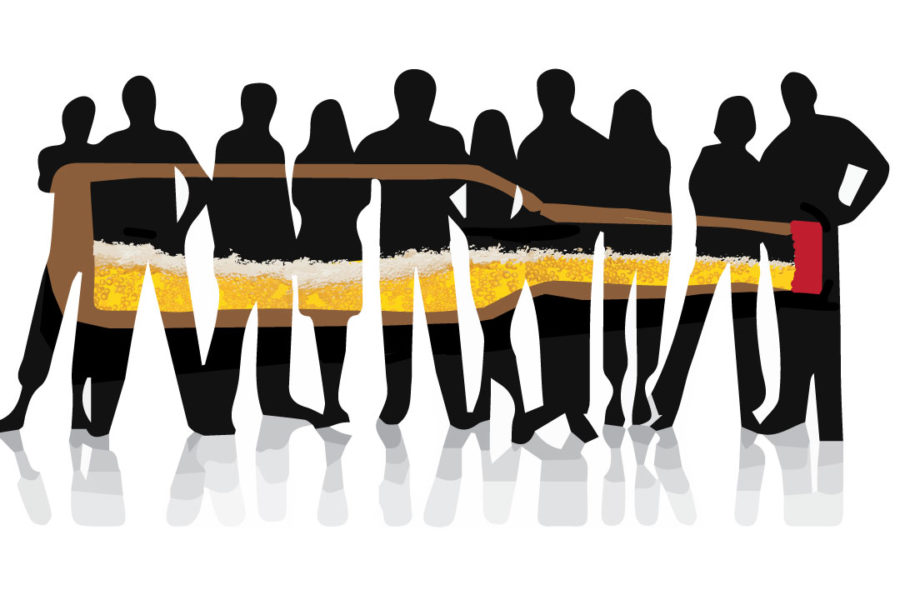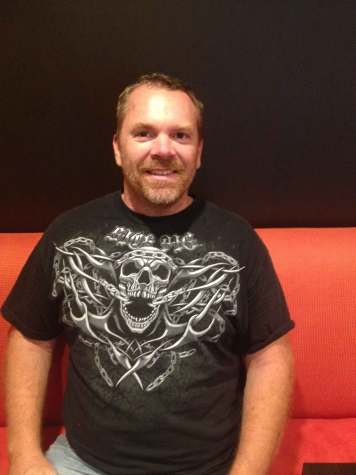After shuffling between school expulsions, arrests and a five-year prison sentence, former Santa Rosa Junior College student Phil Parfitt’s path of self-destruction is now a 17-year-long path of self-construction.
“I can’t believe it. I feel good inside. I never thought that it was possible,” he said.
Parfitt, 44, had lost his son to Child Protective Services (CPS) after his girlfriend was arrested for selling methamphetamine while he was serving time for his fourth felony. Despite his early release for good behavior and desire to get his son back, he didn’t take his recovery process seriously, only doing it for the courts.
“But at some point it all changed,” he said. “CPS had me do anger management, parenting classes and outpatient drug rehabilitation at [Drug Alternative Abuse Center] in Santa Rosa.”
He became clean and sober for two years, enrolled at SRJC, transferred to Sonoma State University and completed rehab. “I was clean and sober, but not happy at all,” he said. “Drugs were my escape from everything. I felt alone. I noticed that the other students seemed happy and had goals in their lives.”
Parfitt attributes his change in attitude to Alcoholics Anonymous’ 12 Steps program.
“I learned how to treat other people and to not always try to get but give,” he said. “Slowly people befriended me, and I started recognizing people from AA and [Narcotics Anonymous] in the process of bettering themselves also. I realized I could change and that gave me hope.”
According to the Diagnostic and Statistical Manual of Mental Disorders in 2013, an estimated 21.6 million people aged 12 or older were classified with substance dependence or abuse in the past year, 14.7 million of which were dependent on or abusing alcohol but not illicit drugs and 2.6 million were classified with dependence or abuse of both.
The disease of addiction does not discriminate. Not only does it permeate every level of an addict’s life, but it also engulfs the lives of those around them. Untreated alcoholism and drug addiction ruins lives, and intervention is sometimes necessary to come face-to-face with addiction.
SRJC student Jaylene’s path to recovery started when her daughter’s father told her if she did not go to the Orenda Detox Center’s 31-day inpatient program, she wouldn’t be able to see her daughter. At that point, she admitted she had a problem and checked herself in.
Jaylene has attempted to go to school more than once at SRJC with some periods of success, but sooner or later the consequences of her drinking and drug use got in the way. “I was trying to go to school and using needles and methamphetamines and spending all of my FAFSA money,” Jaylene said.
During the Fourth of July weekend in 2013, Jaylene was staying at the Samuel L. Jones Homeless Shelter. With money she received from the Human Services Department’s General Assistance Program, instead of using it for drinking or using drugs, she made a decision. “I can throw my life away one more time or check into [the] Sam Jones Homeless Shelter and get off of drugs,” Jaylene said. She is now an SRJC student once again, clean and sober and a member of AA and attends meetings on a regular basis.
The majority of health risks due to drug and alcohol abuse potentially occur over the course of one evening, not after decades of abuse. According to a 2013 SRJC National College Health Assessment II survey, 35.5 percent of students did something they regretted, 28.8 percent forgot their locations or actions, 23.4 percent had unprotected sex and 17.8 percent were physically injured when they were drunk.
According to John Lavitt, a reporter for the Fix, the Comprehensive Addiction and Recovery Act of 2014 is a rare bipartisan effort to make $80 million available to states and local governments to expand drug treatment, prevention and recovery.
“[It] represents a significant step forward in how we understand and address addiction,” said Patrick Kennedy, a former congressman from Rhode Island who previously suffered from drug and alcohol addiction. “The bottom line is that addiction and other mental illnesses are treatable, and recovery is real.”
Cheryl Sherwood, an SRJC groundskeeper for 15 years, has found evidence of students engaging in alcohol and drug abuse on campus. Another gardener told her he had found four bottles of Crown Royal in his garbage can in a week.
“I mean that’s a lot. We find them in the trash all over campus. They throw them into the shrubs and they leave them in the parking lots,” Sherwood said.
SRJC and the greater community offer resources for students to address their addiction, whether they are in or out of recovery.
Cindy Dickinson, an SRJC nurse practitioner, conducts 15-minute sessions to examine students’ general wellbeing.
“A lot of students’ drug and alcohol problems are discovered while taking care of their physical complaints,” Dickinson said. “Someone may be smoking marijuana to calm themselves, or maybe alcohol has become a big issue, or there are a variety of different drugs that they are using and that there may be a problem. Students get very brief, limited cognitive therapy that is helpful for a number of conditions, but it’s not enough.”
If students don’t want to give up their academic units and need more guidance, Dickinson refers them to the California Human Development Corporation’s outpatient program, which has services in both the daytime and evening and works around students’ schedules. If a student needs to show up every day, someone will always be there to offer assistance.
SRJC currently doesn’t screen for drugs and alcohol because there is no set system of referral and intervention. Student Health Services staff is working with the county on a program called SBIRT, standing for Screening, Briefing, Intervention, Referral and Treatment. It is a comprehensive and community-based effort supported by programs like the Drug Abuse Alternative Center (DAAC) in Santa Rosa, which provides thousands of individuals and families with tools and guidance to live free from the bonds of drug addiction and alcoholism. The DAAC facilities are within walking distance from SRJC and serve all of Sonoma County.
According to Jeane Erlenborn, an SRJC health promotions specialist, DAAC has been a great resource for SRJC students, but is underutilized. “We know that substance abuse gets in the way of being a successful student and that students are really busy,” she said. The Student Health Services’ mission is to accommodate students in any way they can support their sobriety and ability to succeed.
SRJC provides the educational component necessary for certification through the California Association of Alcohol and Drug Educators (CAADE). Students completing the coursework are eligible to take the exam to become an Addiction Treatment Specialist. The SRJC Human Services Alcohol and Drug program is accredited by CAADE.
Due to students requests, SRJC has added three new AA meetings a week starting Monday, Oct. 4 and continuing through the week. They meet at 9 a.m. Wednesdays, Thursdays and Fridays. In addition, an Al-Anon, a support group for those affected by someone else’s drinking or drug use, also has 12-step meetings on Mondays from noon to 1 p.m. in Plover Hall, Room 540. The original Thursday AA meetings are still taking place at noon.
“The wonderful thing about the 12-step program is not just personal recovery but the creation of community and people feeling understood,” Dickinson said. “There is so little long-term therapy available right now for SRJC students.”
According to Dickinson, AA can be a free and effective tool for students. “They might find it’s a pathway, not only to recovery but self-discovery,” she said.
Greg J. is an AA volunteer and currently a meeting secretary at the Campobello Rehabilitation Center. He has volunteered to run the new AA meetings on campus until he finds secretaries willing to make the standard six-month AA commitment.
While attending a meeting on campus and living in a nearby Sober Living Environment, he noticed the struggling AA meetings needed help. “This was an opportunity for me to give back to something that was given to me,” he said.
Parfitt said his courses in sociology and psychology taught him that most people end up repeating the way they were raised, which is why he only saw his son on weekends.
After achieving sobriety, he reconnected with his son, who just became a high school graduate, a title Parfitt never earned.
“He has never been in trouble. He is a happy kid with goals,” he said. “I am just happy I could be a positive person in his life, and not someone who brought him down.”
Q&A with Phil Parfitts
Q. At what stage of your recovery did you decide to attend SRJC and what were the results?
A. I knew I wouldn’t maintain my sobriety, which became important, so I enrolled in college. It kept me busy; it got me off the street and gave me some direction. If I had free time to hang out in downtown Santa Rosa, I knew I would just get back into trouble.
School was simple but it was very hard to relate to other people. After being locked up basically for four years I just didn’t know how to communicate with normal people in any way.
So I was clean and sober but not happy at all. I mean, drugs were my escape from everything. I felt alone. I had all my walls up and didn’t let anyone in. I noticed that the other students seemed happy and had goals in their lives. Slowly people befriended me, and I started recognizing people from AA (Alcoholic Anonymous) and NA (Narcotics Anonymous) in the process of bettering themselves also. I realized I could change and that gave me hope.
I took sociology, psychology and technology/computer classes, 12-18 units per semester. I got my A+ computer hardware certificate, Net + computer networking certificate and Cisco, a more in-depth computer networking certificate. I got my A.A. from SRJC and transferred to Sonoma State, graduating with a BA in sociology in 2008.
Q. When did you feel things started improving in your life or one of the major turning points in your recovery?
A: With all of my rehabilitation services through Child Protective Service (CPS), school was starting to resocialize me to society. I didn’t have to be on guard all of the time. I learned that not everyone in the world was a threat. I could trust people. Life wasn’t hell.
I realized it wasn’t an outside thing, it the inside. It was all my perspective.
Q. What would you say to an SRJC student struggling with alcohol and drug addiction?
A. If you’re still going to the JC, you have a lot to lose if you go down the path of self-destruction. You could end up on the street like I did. You don’t have to go down that far to realize that your life is unmanageable. It’s going to take you to those other places I’ve already been. I would tell them there are a lot of resources at the school: counselors and people they can talk to. I would also recommend checking out AA and/or NA and get a support system.





Doug Sutro • Oct 22, 2014 at 1:56 pm
Hi
At the Sonoma County Law Library $45 Substance Abuse Prevention 1.5 units for the State Bar.
The flyer is on the front page of the web-site above.
Mark Susnow, JD, former trial attorney, is the speaker. I will be there and have heard good things about him. You don’t have to be an attorney to go.
Friday, October 24th, Noon to 1:30 pm